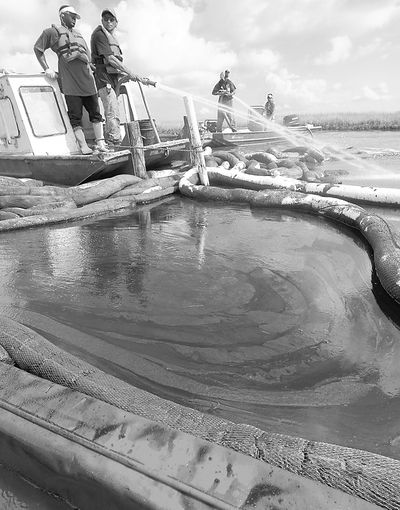Spill fighters think small
Oil-eating microbes eyed as bio-solution

MIAMI – One scientist compares them to the yellow chompers in the Pac-Man video game – hungry, single-minded little microbes fueled by the same fertilizer farmers use on soybeans, gobbling hydrocarbons from the oily waters, marshes and shores of the Gulf of Mexico.
Can the naturally occurring microbes help clean up the oil spill? Yes, experts say. At least in part, with some risk.
Officials are taking note. Florida Gov. Charlie Crist on Thursday visited a Sarasota company that sells microbes that eat oil. BP says it’s open to using them. And the federal government is contacting its pre-approved list of more than a dozen companies to see how quickly they can ramp up production.
Scientists call the process bioremediation.
“You take natural oil-eating microbes in the water and give them fertilizer to make them multiply and degrade the oil faster. Oil is a natural product. It’s inherently biodegradable,” said Terry Hazen, microbial ecologist in the Earth Sciences Division of the Lawrence Berkeley National Lab in California.
Oil-eating microbes are some of the smallest living things on Earth, but they can have a powerful impact. They occur naturally in water and when they come in contact with oil, they eat it, producing the byproducts carbon dioxide and water. When fertilized with nitrogen and phosphorus, they grow in size and multiply and their appetites become prodigious.
Still, scientists caution that bioremediation is only a partial solution. It’s best used on sandy beaches and in salt marshes after the thickest oil has been removed by bulldozer and shovel. It’s never been tried before in deep water or open ocean.
And it runs some risk of damaging the very waters it’s meant to rescue. Some scientists say it may be better at times to let nature take its course.
Bioremediation can’t do the whole job, said Chris Reddy, marine chemist at Woods Hole Oceanographic Institution in Massachusetts.
“The idea that microbes can come in and clean house from A to Z is not likely,” he said. “What they can do – on their own time – is eat some compounds and play an important role in the cleanup.”
The federal government is working on possible bioremediation efforts. The EPA has created a National Contingency Plan Product Schedule listing more than 20 biological agents approved for use in encouraging microbes to attack oil spills. And the USDA’s Natural Resources Conservation Service is contacting the companies that make them to see how quickly they can ramp up production.
But there’s a danger. Add too much fertilizer and you can create blooms of algae that use up all the oxygen in the surrounding water, creating “dead zones.” There’s already a 6,000-square-mile dead zone in the Gulf off the mouth of the Mississippi River, created years ago by the same fertilizers washing down from upriver farms.
“It’s pretty big and pretty scary,” said Jim Spain, professor of environmental engineering at Georgia Tech.
The microbes are neither plant nor animal. They’re bacteria, with names like “Alcanivorax borkumensis.”
But the huge BP spill has overwhelmed existing microbes. To grow enough in size and number to cope with the spill, they need nitrogen, phosphorus and iron.
“They’re like Pac-Men – their mouths are only so big,” Reddy said. “Their ability to eat oil is closely coupled to their number.”
Fueled by fertilizer, the microbes can multiply and eat the oil. That’s the upside. The possible downsides are less well-understood.
“There hasn’t been a full-scale addition of fertilizer in the open ocean to clean up a spill,” Spain said. “There’s never been an experiment as big as this. We have to be very careful.”
Scientists differ on whether fertilizing natural microbes can help degrade deep oil plumes as far as 3,300 feet beneath the surface of the Gulf. Georgia Tech’s Spain said he fears fertilizing microbes at great depths might use up the tiny amounts of oxygen that exist there, creating even more oxygen-depleted dead zones.
Despite its shortcomings, bioremediation of oil spills has influential supporters.
Albert Venosa, an environmental expert at the EPA’s National Risk Management Research Laboratory who studied the issue, told a U.S. House subcommittee on June 9: “Bioremediation can be very effective on sandy marine shorelines, wetlands and salt marshes. But it is much slower (than mechanical means) – weeks to months or more – and is not usually considered a first response.”